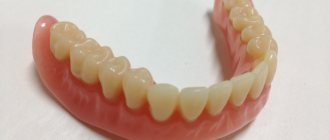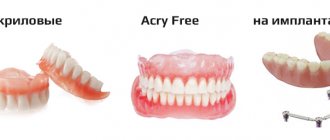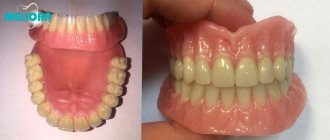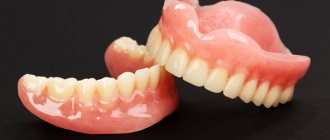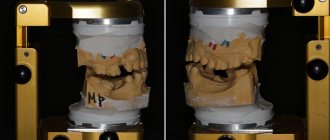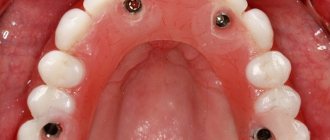From this article you will learn:
- how to improve the fixation of complete removable dentures,
- types of overdentures, reviews,
- price for 2021.
Conditionally removable (covering) dentures are a type of dental prosthetics in the complete absence of teeth, when several dental implants are installed under a removable denture in order to improve its fixation on a toothless jaw. Fixation of such prostheses to implants installed in the bone tissue of the jaws is carried out using special locking fasteners. Such attachments can be push-button or bar-type, for example, through ball-shaped abutments, Locator® equatorial abutments, and cast or milled bars (Fig. 1-3).
Dentures of this type are called “conditionally removable” in dentistry for the reason that you can only remove such a denture if you apply sufficient force. However, patients more often call them by the term “overdentures”. Their biggest advantage is that they never fall off while talking or chewing. It should also be noted that dentures of this type can be used not only with complete, but also sometimes with partial absence of teeth.
Conditionally removable prosthesis: photo
* The minimum cost of a conditionally removable prosthesis on implants will start from 100,000 rubles (detailed options for prostheses and prices - see below).
Advantages of conditionally removable dentures –
Traditional removable dentures made of ordinary acrylic plastic are very poorly fixed on toothless jaws. This is due to the fact that under removable dentures, atrophy of the alveolar processes of the jaws (on which the denture “sits”) gradually occurs. This leads to a gradual decrease in the height and width of the alveolar processes - in proportion to this, the fixation of the prosthesis worsens.
Advantages of dentures on implants -
- excellent fixation even with severe bone atrophy,
- immediate prosthetics,
- comfort - such dentures have a smaller plastic base (on the upper jaw the denture is made with virtually no overlap of the palate),
- relatively affordable price.
What dentures are called conditionally removable – types and what they look like
What is a conditionally removable denture on implants? The name of such structures is quite justified: unlike removable ones, they are more securely fixed in the oral cavity - and the patient does not need to constantly remove them for cleaning. But at the same time, conditionally removable ones are removed from the support for cleaning or correction without replacing the implants. In composition and appearance, conditionally removable ones are in many ways similar to classic removable ones, but are supplemented with special fasteners.
Prosthetic structures consist of the following components:
- artificial crowns, which can be made of plastic, metal-plastic, metal-ceramics, zirconium dioxide or ceramic composite,
- artificial gum made of acrylic, which can be further reinforced with diamond chips or use hypoallergenic monomer-free acrylic,
- fixing elements for fastening to implants: beams or “buttons”.
In size, conditionally removable structures can be full or covering, i.e. restore the entire dentition. But they can also be used for prosthetics in the absence of several teeth - a partial structure (a bridge with artificial gum) is suitable here.
PROSTHETICS WITH 6 OSSTEM IMPLANTS FROM RUB 200,000.
Complex implantation Osstem (South Korea) with delayed loading after 4-6 months.
Call now or request a call
Conditionally removable dentures also differ in how they are installed on implants - we will consider these methods further.
All-on-4
The All-on-4 technique (all-on-four) was developed by Nobel Biocare. It involves the installation of 4 implants on one jaw with simultaneous loading with a fixed prosthesis on a screw fixation. The 2 outermost implants are placed at an angle of up to 45 degrees, which allows you to bypass anatomically difficult places: the maxillary sinuses in the upper jaw and the nerve exit site in the lower jaw.
Initially, the All-on-4 technique was positioned as minimally invasive, without bone grafting. However, for successful functioning it is necessary to install sufficiently long implants, because 4 implants must bear the load of the entire dentition. Unfortunately, not all patients have the required alveolar ridge height. Installing shorter implants may result in one of the implants not taking root due to increased load. And then everything-on-four will turn into nothing-on-three. This is why patients are offered “all-on-4 modifications”, for example All-on-6 (all-on-six implants), because Installing an additional 2 implants significantly reduces the risks.
3-6 months after implantation using the All-on-4 method, gaps appear between the prosthesis and the gum, because This is why gum remodeling occurs after implantation. It is necessary to either reline the existing prosthesis or replace it with a permanent one - metal-ceramic or zirconium.
Ball-shaped implant mounting system
Special abutments are placed on the tops of the implants, which look like a ball from above - this is a spherical mount. Metal fasteners are installed in the inner part of the prosthetic base (their number is equal to the number of implants), and each fastener also has a rubber or silicone ring to hold the spherical part of the abutment.
The prosthesis snaps onto spherical aba) and is easily removed at home. But, despite the ease of installation/removal and low cost, such fasteners last a maximum of 2-3 years, because the balls wear off on the sides, become flat, and the prosthesis begins to wobble and fall out. And before implantation, check with your doctor whether the selected abutments can be replaced or not, otherwise there is a risk of their removal along with the implants.
How does the procedure work?
Attachment of microprostheses occurs as follows:
- metal paws in the teeth, localizing the defect. Form grooves where the prosthesis is attached;
- special cement. The micromodule is fixed on adjacent incisors using a solution that is polymized under the influence of ultraviolet radiation and chemically;
- micro locks. The matrices are attached to adjacent teeth or crowns standing on them.
The last two methods make structures invisible to humans and others.
Mounting on equatorial type abutments (Locator)
The equatorial fastening is also of the push-button type, only here the top of the abutment is presented not in the form of a ball, but in the form of a cylinder. The development of equator attachments belongs to Straumann, one of the three leaders in the implantation industry. The original “locators” are made of the strongest titanium and do not break or wear out under load. Therefore, they do not need such targeted observation as spherical ones (i.e., you will need to visit the dentist less often). In general, the equator type is superior to spherical abutments in terms of quality of fixation, wearing comfort and service life, but, accordingly, it is more expensive.
Cost of prosthetics for complete absence of teeth
The price of prosthetics with implants if all teeth are missing is not cheap, but it is fully justified by its results: aesthetics, reliability, durability. Titanium roots can serve for many years without losing useful characteristics, so all costs for prosthetics will be covered. In addition, the implantation procedure is carried out in several stages and is also paid for - payment is made separately for each stage, which makes it possible to calculate and plan upcoming costs.
The final cost of the service for the patient will be influenced by a significant number of different factors, including: the type of orthodontic product, the material of its production, the type of implant, the manufacturer of the implantation system, the method of prosthetics, the need for additional therapeutic procedures before prosthetics. Having considered all the factors in determining the price of prosthetics on implants and taking into account all the features of a specific clinical case, it is always possible to choose the implantation option that will suit the patient in terms of quality, price and result.
However, remember - the price of implantation should not be a fundamental factor if you want to receive a service of decent quality. Neither the implants themselves nor the services of an implantologist can cost a penny, since the procedure is complex and requires the use of expensive consumables and equipment. Therefore, we advise you to contact not those clinics that attract patients with low prices in their price lists, but dentists that offer fair prices for implantation. In our dentistry in Moscow, Vanstom, you can get high-quality dental services at real prices! Come to our clinic: we are located next to the Baumanskaya metro station, in the center of the capital.
Beam mounting on implants
There are several types of beam fastening, which are quite easy to get confused about. Therefore, let’s immediately clarify and consider in more detail.
The beam rests on implants – standard conditionally removable prosthetics
It is with conditionally removable prosthetics that there is no beam in the prosthesis itself - it is lightweight, contains crowns and a plastic base. The base has a kind of empty “tunnel” that is put on the beam (and it is fixedly fixed to the implants). Such a prosthetic structure can be easily removed and re-fixed not only by the dentist, but also by the patient himself - therefore, this type refers to conditionally removable prosthetics in the usual sense.
The beam is “implanted” inside the prosthesis itself - fixed prosthetics on implants (or relatively conditionally removable)
There is a built-in metal beam (or frame) inside the prosthesis, that is, it is impossible to separate the beam from the base - they are one whole. This design is more durable and better transfers the chewing load to the bone, and also helps to splint the implants on top. Fixation of the “reinforced” prosthesis is carried out by several screws that are screwed in from above - pass through a through hole in the crowns and prosthetic base, and are fixed to the implants.
And to disguise the screws, the dentist fills the hole in the crowns with a special durable compound. To remove the orthopedic structure, the doctor will remove the filling and unscrew the screws - this is easy to do in dentistry, but impossible (and prohibited!) at home. Therefore, for the patient such a prosthesis is non-removable, but for the dentist it is relatively conditionally removable.
Tips for choosing the type of implants
For prosthetics on implants, products of different types and from various global manufacturers can be used. Artificial roots for implantation are available in a wide range of types and prices, but not all of the implantation systems present on the market have passed the necessary clinical trials and time-tested. In addition, not all implant options are widely used in Russia, which can lead to difficulties if it is necessary to additionally order any components for the system.
When choosing a system for prosthetics on implants in the absence of teeth, you should first consider the options offered by world-famous manufacturers and widely used in modern dentistry. When selecting implants, close attention should be paid to its connection, since the density of the artificial root in the bone and its stability and ability to withstand increased loads depend on this element.
It is also worth studying the data on the material used to manufacture implants. Research shows that the healing process of those structures that are made of pure titanium occurs faster. The more impurities are added to the production material, the longer the process of integrating the implant with the natural tissues of the human body will take. No less important is the type of surface of the implants that will be used during the restoration process.
Each brand manufacturer processes implant surfaces using its own unique technology. Special treatment of the surfaces of implants from some companies makes it possible to ensure and accelerate the process of fusion of the structure with the natural bone material of the human body, and in addition, makes it possible to use implant systems in people suffering from various pathologies of the blood and blood vessels, and autoimmune diseases.
And one more key point: even after studying all the criteria for competently choosing implants for prosthetics, do not make your own choice of system. Only a qualified implantologist can select implants and the procedure method after assessing the clinical picture of a particular case. For detailed advice from a specialist in prosthetics on implants, contact our dentistry in Moscow - Vanstom! Address of our clinic: Moscow, Baumanskaya metro station, st. Bakuninskaya, 17/28.
Calculate the cost of treatment by taking a short test in 20 seconds!
Do not delay your treatment, because in this matter time plays against us.
Advantages and disadvantages
Considering the pros and cons of conditionally removable dentures on implants, we will first dwell on their advantages relative to conventional “false jaws,” which look like this:
- more reliable fixation than classic removable ones: dentures are motionless during chewing food and talking, spontaneous loss of dentures is excluded,
- the ability to eat harder foods and chew food more thoroughly than with conventional removable ones,
- excellent appearance: due to hidden fastening and a less massive gingival base,
- conditionally removable ones are significantly less massive than removable structures,
- comfortable wearing: they do not rub the gums and do not cause a gag reflex, since they are attached only to the tops of the abutments or on the beam,
- usually the cost of prosthetics is significantly less than with classic fixed prosthetics on implants,
- very simple care and operation: the structures do not need to be removed from the mouth after each meal, and there is no need to additionally use fixing creams. But, of course, you need to clean such dentures and the entire oral cavity after every meal.
Conditionally removable dentures on implants also have disadvantages - these are contraindications for implantation, high cost (compared to traditional prosthetics), as well as fairly rapid wear and loosening of fastening elements.
Prostheses with push-button fixation –
At the first stage, implants are installed in the jaw, the number of which will depend both on their diameter and on whether prosthetics will be performed on the upper or lower jaw. In the upper jaw, 4 implants are usually installed - regardless of their diameter, which is due to the presence of a softer type of bone in the upper jaw.
On the lower jaw, if mini-implants (1.8-2.4 mm in diameter) are used, 4 of them are also installed. Moreover, the use of implants of such a small diameter allows you to almost always avoid bone grafting - if the patient has thin alveolar shoot. However, if implants with a diameter of 4-5 mm are used, only 2 of them can be installed, but 3-4 are still better, because this will improve the stability of the prosthesis.
Prosthesis fixation system - after installing the implants, abutments are screwed into them, which will protrude above the surface of the mucous membrane and serve as an element for fixing the prosthesis. For these purposes, two types of abutments can be used: spherical or equatorial. Which type of fixation (using which abutments) is better – we explain in detail below.
1) Fixation on ball-shaped abutments –
Below we show a diagram of fixing a removable denture on ball-type abutments. You will find a detailed description below.
After installing the implants, abutments are screwed into them (or the implants may already have permanent abutments). Externally, the spherical abutment looks like a metal ball-shaped head protruding above the mucous membrane (Fig. 4). Such spherical abutments are the first half of the mechanism for fixing a removable denture on implants. The second half of the locking fastening is located in the base of the prosthesis.
In the projection of each implant with a spherical abutment, a recess is made in the base of the prosthesis into which a metal holder for a silicone matrix is inserted, of course, along with the matrix itself. The silicone matrix is something like a rubber sealing ring (Fig. 5). When putting on the prosthesis, the head of the ball-shaped abutment passes through this ring, which then tightly holds the abutment (Fig. 6). After this, the prosthesis can be removed only by applying sufficient force.
Fixation of the prosthesis on ball-shaped abutments: photo
Important: the big disadvantage of the fixation system on ball-shaped abutments is that they tend to wear out as a result of friction in about 2-3 years. As a result, the abutment head becomes flatter and the silicone matrix holds it less and less well. That is why it is worth installing only those implants in which the ball-shaped abutment can be replaced with a new one.
If you install implants that already have permanent abutments, then in order to replace them, you will simply have to install the implants again. To reduce the rate of wear, some companies coat the abutments with special coatings, but this is still not a long-term solution to this problem.
2) Fixation on equatorial abutments (Locator®) –
This fixation system is called Locator® (Fig. 13-15).
For patients, it is more comfortable in terms of removing and putting on a removable denture, and also allows them to visit the dentist less often to service the prosthesis fixation system. It allows implant surgeons to place implants in the jaw at large angles relative to each other, which is necessary in case of severe atrophy of the jaw bone tissue. Equator abutments differ from spherical abutments in their shape, which affects the nature of the interaction between the abutment and the silicone matrix. With this system, a holder for the matrix is also built into the base of the removable denture (along with the silicone matrix itself) - in the projection of each installed implant with an abutment. Equator abutment dentures are more comfortable and require less maintenance.
Fixation of the prosthesis on the equatorial abdomen: photo
Features of prosthetics with prostheses with push-button type of fixation –
The manufacture of a prosthesis, both when using spherical and equatorial abutments, in most cases can be carried out immediately after surgery (especially on the lower jaw). Those. Impressions will be taken immediately and within a few days a prosthesis will be made from either regular acrylic plastic or slightly elastic Acry-free material (this option will be more expensive).
However, if you already have a prosthesis (provided that it is well made and is no more than 2 years old), you will be able to use your old prosthesis without making a new one. To do this, recesses will be made in your old prosthesis and locking fasteners - silicone matrices - will be installed there.
Advantages of push-button type fixation:
- technical ease of manufacture,
- more affordable price,
- implants with push-button fastening can be installed even under an old prosthesis,
- simpler hygiene (less risk of inflammation around implants in the future).
Disadvantages of push-button type locking –
- Weakening of the fixation over time requires periodic replacement of silicone matrices, and in the case of spherical abutments, the matrices will have to be changed several times more often - approximately once every six months (compared to the use of equatorial abutments, where the matrices are changed less frequently).
Overdentures with fixation “Locator”: video
Indications and contraindications
The following situations are indications for prosthetics:
- absence of several teeth (segments and sectors),
- absence of all teeth (complete edentia),
- the need for more reliable fixation of the prosthesis in the oral cavity for patients experiencing discomfort when wearing classic removable orthopedic structures.
Contraindications include the inability to maintain oral hygiene, the inability to place implants (for serious illnesses, allergies to anesthesia, pregnancy, etc.), allergies to acrylic plastics.
When you can't do without dentures
There are practically no contraindications for conditionally removable prosthetics, with the exception of pregnancy, drug addiction and some mental disorders. Everyone else should consider this method of recovering lost elements. Conditionally removable dentures make it possible to completely restore chewing functions and the charm of a Hollywood smile. Some people ignore tooth loss, but even partial edentia can lead to dire consequences. The nearest elements begin to tilt towards the void, the bite deteriorates, and due to the uneven distribution of the load, deformation of the maxillofacial system begins. All this leads to the need for conditionally removable prosthetics. With qualified selection of materials and professional work of the dentist, the products can last for 5–10 years. Indications for conditionally removable prosthetics are the following factors:
- absence of several elements of the dentition in a row;
- complete edentia of the upper or lower jaw;
- the need for temporary orthopedic construction;
- psychological unpreparedness to wear removable dentures;
- impossibility of installing permanent bridges.
IMPORTANT! If you do not restore your dentition, headaches may appear, and your immune system becomes weakened due to the penetration of pathogenic microbes into the body. The oral cavity must be protected from external influences. The most reasonable way is conditionally removable prosthetics.
Stages of dental restoration
- preparation for implantation: identification of possible contraindications, treatment of remaining natural teeth and gums, removal of diseased teeth,
- installation of implants: in most cases, it is carried out by a small puncture of tissue, after which no stitches are applied, because there is no severe damage to the gums and bones,
- taking impressions and making orthopedic structures, which takes place in a dental laboratory,
- fixation of conditionally removable structures by snapping clamps onto abutments or a beam.
Bone grafting for jaw implantation
The more implants are installed, the greater the likelihood that the existing bone tissue will not be enough to install implants and it will be necessary to build it up. Bone deficiency can be in thickness (very thin bone) or in height (close to the maxillary sinuses in the upper jaw, nerve in the lower jaw).
If there is a slight lack of bone tissue in thickness, one-step bone grafting with the installation of implants is possible. It is also possible to carry out a sinus lift (a type of bone tissue augmentation when the distance to the maxillary sinus is insufficient) with the one-step installation of implants.
If there is a large deficiency of bone tissue, operations are first performed to build it up (open sinus lift, harvesting and replanting of a bone block), and after 3-6 months, implantation is performed. In this case, the total duration of treatment can be from one to one and a half years.
What is known about service life
The service life of conditionally removable dentures on implants is 5-7 years (and implants last a lifetime). But there are nuances here. Firstly, artificial jaws should be properly cared for and should not be used to chew excessively hard food. Secondly, you need to regularly visit your dentist for a professional examination - it may be time to change the abutments or make a new prosthetic structure to replace the worn one.
“The prosthetist immediately warned me that after some time I would have to change the prostheses (it’s good that there is no need to change the implants). He said that I need to be observed 1-2 times a year or if something hurts. There, at the appointment, they immediately take an x-ray and “candouble” the implants. After 4 years I had to have a new jaw made, because the old one was probably actively chewed. Or because it is made of not very good plastics. Don't know. This time I chose some new reinforced material, it seems to be German. I think it will last longer.” Petr Sergeevich, review from the website stomatology.rf
Don't know what type of prosthetics to choose?
We will help in the selection, advise where to read more information and compare types of prosthetics.
Consultation with an orthopedic doctor in Moscow clinics is free! Call now or request a call
Working hours: from 9:00 to 21:00 - seven days a week
There are two significant disadvantages to the clasp prosthesis:
- To install it, you need to have your own (at least several) teeth;
- It is more expensive than its LP counterpart.
However, there is good news for patients of the professor’s clinic: prices for dental and orthopedic services in the clinic are affordable, and consultation with the head physician is free . We offer favorable conditions for prosthetics using modern materials, technologies and equipment.
Date of publication: September 20, 2020 Last update: September 22, 2021 © 2020 Professorial Dentistry “22 Century”. All rights reserved.
Structure care
Caring for conditionally removable dentures on implants is quite simple. Artificial teeth need to be brushed twice a day - a regular toothbrush and toothpaste without abrasive particles will be useful so as not to scratch the surface. From time to time, orthopedic structures must be removed for more thorough cleaning (1-2 times a month). It is also recommended to use an irrigator to remove food debris and plaque in hard-to-reach places. Do not forget about visits to the attending physician, who will be able to carry out more thorough hygiene not only of the external, but also of the internal part of the prosthesis.
Clasp dentures - a modern type of removable dentures
The clasp removable denture is compact, durable, and easy to get used to, as evidenced by the reviews of the patients themselves.
In the clasp denture, instead of a plate, a fairly thin arch , made of high-strength metal alloys. Artificial teeth are fixed to the arch. A clasp denture is more physiological: the load during chewing is evenly distributed on the gums, jaw and remaining teeth (in a plate denture, the entire load falls on the bone tissue of the jaws).
Clasp removable dentures are compact, durable , and easy to get used to, as evidenced by the reviews of the patients themselves.
The clasp denture has a very reliable fixation, and if during its manufacture locks were installed instead of clasps, then it will be impossible to guess that the patient is wearing a removable denture.
The cost of prosthetics and what it depends on
How much a conditionally removable denture on implants costs depends on the materials from which it is made, as well as on the method of its production. The cost also depends on the scope of work, for example, the price of a full covering acrylic prosthesis together with implantation (mid-price segment implants) is about 90 thousand rubles. The use of premium models of implants and materials for prosthetics will significantly increase the cost.
1Wohlfart S. Prosthetics supported by implants. Planning based on results, 2021.
Author: Sambuev B. S. (Thank you for your help in writing the article and the information provided)
Covering denture: price 2021
How much does a covering prosthesis cost? The prices below are indicated on a turnkey basis for 2021 (in economy-class and mid-price clinics). The price of the prosthesis will primarily depend on the type of fixation, as well as the number of implants installed.
- Prosthesis on 4 mini-implants Osstem (Korea) with fixation on spherical abutments - the price will be from 100,000 rubles.
- Prosthesis on 2 MIS implants (Israel) with fixation on ball-shaped abutments - price from 110,000 rubles.
- Prosthesis on 2 AstraTech implants (Sweden) with fixation system Locator® – from 140,000 rubles.
- Prosthesis on 2 Straumann implants (Switzerland) with Locator® system fixation – price from 160,000 rubles.
- Beam-type prosthesis on 4 Roott-Form implants (Switzerland) – price from 280,000 rubles.

